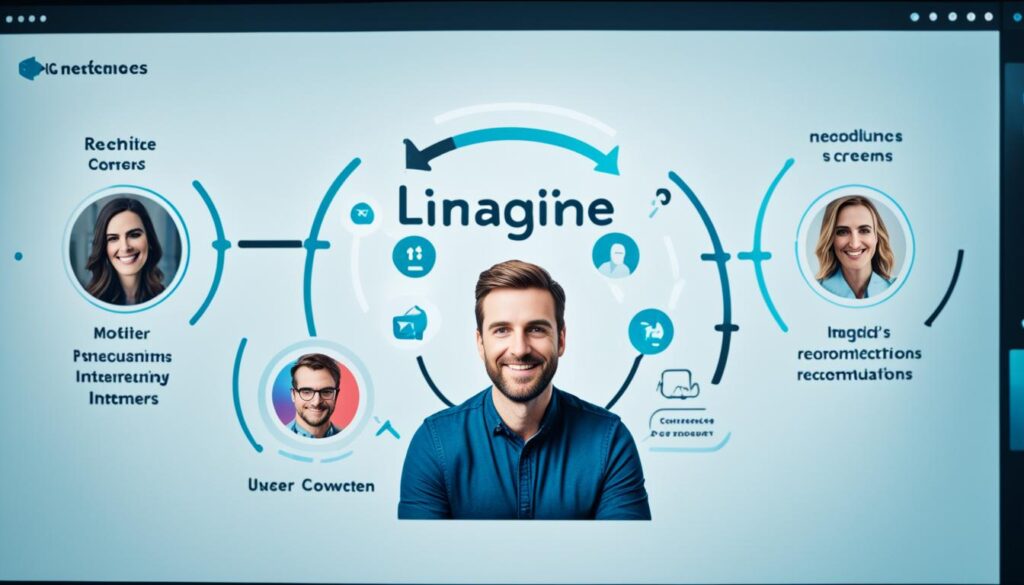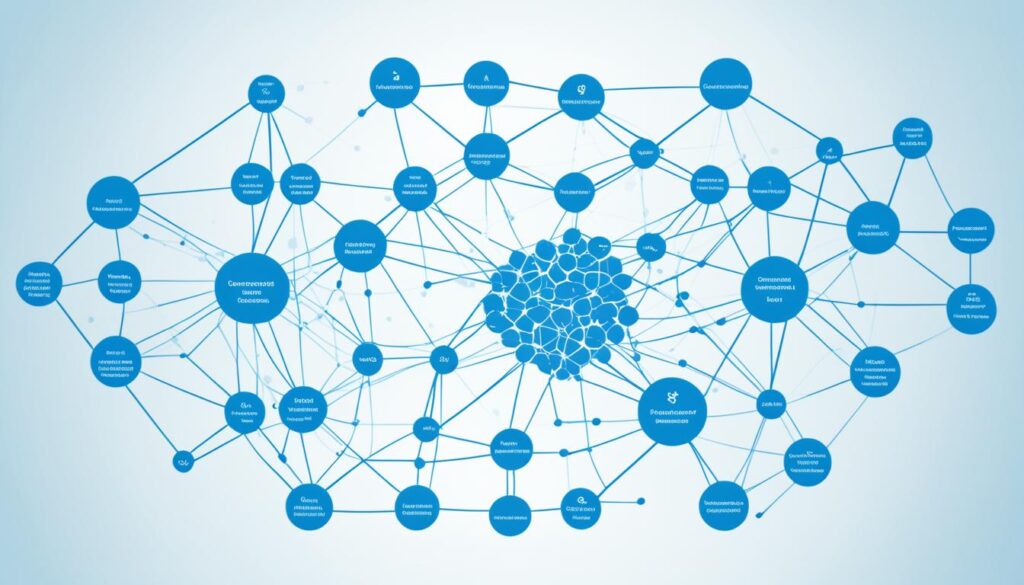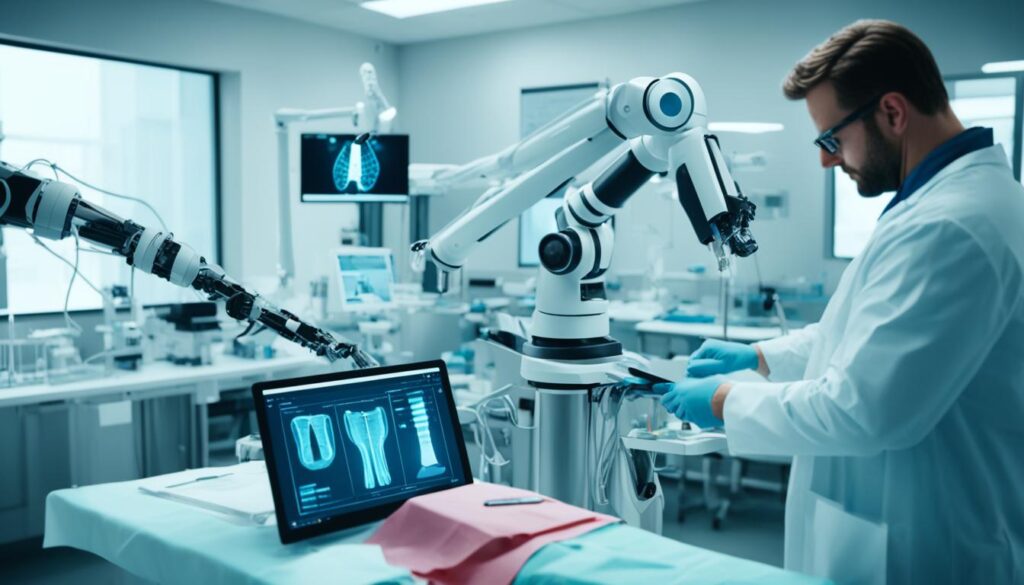Deep learning, a subset of machine learning, has emerged as a game-changer in the field. By harnessing the potential of artificial neural networks (ANNs), deep learning models can unravel complex patterns and representations in large-scale data. This technology has revolutionized various applications, including speech recognition, image processing, and natural language processing.
One area where deep learning is making a significant impact is recommendation systems. It addresses challenges such as handling large-scale data, cold-start issues, and limited context understanding. Deep learning offers enhanced data processing capabilities, improved resolution of the cold-start problem, contextual understanding, dynamic personalization, and scalability, transforming traditional recommendation systems.
Key Takeaways:
- Deep learning, a subset of machine learning, uses artificial neural networks to model complex patterns and representations in large-scale data.
- Deep learning is revolutionizing recommendation systems by addressing challenges in handling large-scale data, cold-start issues, and limited context understanding.
- Deep learning offers enhanced data processing, improved resolution of the cold-start problem, contextual understanding, dynamic personalization, and scalability.
The Role of Deep Learning in Personalized Recommendations
Deep learning applications have revolutionized traditional recommendation systems by leveraging advanced algorithms and robust data processing techniques. Deep learning plays a crucial role in improving the accuracy and effectiveness of personalized recommendations, enabling businesses to provide highly relevant and tailored experiences to their users.
In recommendation systems, deep learning models excel at processing vast amounts of structured and unstructured data, allowing for more accurate predictions and insights. These models can generate meaningful recommendations even for new items or users with limited interaction history, a challenge known as the cold-start problem.
Deep learning algorithms also enable recommendations with contextual understanding, taking into account various factors such as user preferences, historical behavior, and contextual information. This contextual understanding enhances the relevance and usefulness of the recommendations, ultimately improving user satisfaction.
Furthermore, deep learning models possess the capability to adapt to evolving user preferences and behavior. By continuously learning from user interactions, these models can dynamically personalize the recommendations, ensuring that the suggestions remain up-to-date and aligned with the user’s current interests.
Moreover, deep learning enhances scalability, allowing recommendation systems to handle large-scale datasets efficiently. As the volume of data grows, the deep learning models can process and analyze the information at scale, providing timely recommendations to a growing user base without compromising performance.
The role of deep learning in personalized recommendations goes beyond traditional approaches, offering a seamless and dynamic user experience. By harnessing the power of advanced algorithms and robust data processing, businesses can unlock new levels of personalization and enhance customer satisfaction.

Implementing Deep Learning-Based Recommendation Systems
To harness the power of deep learning for personalized recommendations, businesses need to follow a strategic approach. This includes:
- Data Collection: Gathering relevant data from various sources, such as user profiles, browsing history, preferences, product catalogs, and social media interactions.
- Data Preprocessing: Cleaning, preprocessing, and transforming the collected data into a suitable format for deep learning models.
- Model Selection: Choosing the appropriate deep learning model, such as convolutional neural networks (CNNs) or recurrent neural networks (RNNs), based on the specific recommendation task.
- Model Training: Training the selected model using the preprocessed data, optimizing the model parameters and architecture.
- Evaluation: Assessing the performance of the trained model using relevant metrics to ensure its effectiveness.
- Deployment: Integrating the trained model into the existing recommendation system for real-time personalized recommendations.
- Continuous Improvement: Monitoring the system’s performance and gathering user feedback to further enhance the model and improve recommendations.
By following this implementation process, businesses can leverage deep learning to generate highly relevant and dynamic recommendations that adapt to user preferences and behavior.

| Implementation Steps | Key Points |
|---|---|
| Data Collection | Gather relevant data from various sources |
| Data Preprocessing | Clean, preprocess, and transform the collected data |
| Model Selection | Select the appropriate deep learning model |
| Model Training | Train the selected model using preprocessed data |
| Evaluation | Assess the model’s performance using relevant metrics |
| Deployment | Integrate the trained model into the recommendation system |
| Continuous Improvement | Monitor performance and gather user feedback for enhancements |
The Power of Deep Learning in Other Machine Learning Applications
Deep learning techniques have revolutionized the field of artificial intelligence technology by enabling sophisticated data analysis and pattern recognition. While deep learning is commonly associated with recommendation systems, its applications extend far beyond that. Industries such as healthcare and business have also harnessed the power of deep learning to drive innovation and achieve remarkable outcomes.
Deep Learning in Healthcare
In the healthcare sector, deep learning techniques play a vital role in unlocking the potential of artificial intelligence. By analyzing vast amounts of medical data, deep learning models can assist in medical image analysis, disease diagnosis, and personalized medicine. Medical professionals can leverage deep learning algorithms to identify patterns and detect anomalies in complex medical images, enabling early disease detection and precise diagnostic recommendations.
Deep Learning in Business
Businesses across various industries have embraced deep learning as a powerful tool for optimizing processes, improving customer service, and enhancing predictive analytics. By ingesting and analyzing large-scale datasets, deep learning models can uncover intricate patterns and insights, allowing businesses to make data-driven decisions with greater accuracy. From customer segmentation and demand forecasting to anomaly detection and fraud prevention, deep learning technology empowers organizations to unlock hidden opportunities and mitigate risks effectively.
Deep learning models process complex data and discover intricate patterns in large-scale datasets, enabling more accurate predictions and better decision-making in different domains.
Real-World Applications
Here are some real-world examples that demonstrate the power of deep learning in healthcare and business:
| Industry | Application |
|---|---|
| Healthcare | Medical image analysis |
| Healthcare | Disease diagnosis |
| Healthcare | Personalized medicine |
| Business | Process optimization |
| Business | Customer service improvement |
| Business | Predictive analytics |
These applications showcase how deep learning techniques can revolutionize traditional approaches and bring about transformative advancements in healthcare and business domains.

By harnessing the power of deep learning techniques, industries can unlock new possibilities and drive innovation at an unprecedented pace. As the capabilities of deep learning continue to evolve, there is immense potential for further advancements in healthcare, business, and beyond.
Getting Started with Machine Learning: Foundations and Algorithms
Building a strong foundation in machine learning is essential for understanding the various algorithms and techniques that drive this field. It begins with gaining a thorough understanding of data and exploring its patterns and trends through exploratory data analysis (EDA). By applying data preprocessing techniques such as feature selection, extraction, scaling, and handling missing data, analysts can ensure the data is ready for further analysis.
Machine learning algorithms can be categorized into different types, each catering to specific learning tasks and data structures. The primary categories include:
- Supervised Learning: This category focuses on regression and classification tasks, where the algorithm learns from labeled data to make predictions or decisions.
- Unsupervised Learning: Here, the algorithm processes unlabeled data to discover patterns, clusters, or dimensions within the data. Popular techniques include clustering and dimensionality reduction.
- Reinforcement Learning: This type of learning involves an agent interacting with an environment and learning through trial and error to maximize rewards. Reinforcement learning algorithms are commonly used in robotics and game playing.
- Semi-Supervised Learning: Combining elements of supervised and unsupervised learning, this approach leverages both labeled and unlabeled data to improve learning performance.
- Anomaly Detection: This technique focuses on identifying rare instances or outliers in the data. It is particularly useful in fraud detection and cybersecurity applications.
By understanding the foundations of machine learning and the different categories of algorithms, analysts can leverage the right techniques and methods to solve specific problems, gain insights from data, and make informed decisions.
Evaluating Machine Learning Models and Feature Engineering
When working with machine learning models, it is crucial to evaluate their performance to ensure their effectiveness in solving real-world problems. Model evaluation involves using various metrics to assess the model’s accuracy, precision, recall, and F1-Score.
Confusion matrix is a valuable tool that provides a visual representation of the model’s predictions. It allows us to gain insights into the model’s strengths and weaknesses, understanding how well it classifies different classes.
For example, in a binary classification scenario, the confusion matrix helps us identify true positives, true negatives, false positives, and false negatives. This information aids in analyzing the model’s performance and making informed decisions.
Cross-validation is an essential technique for assessing a model’s generalization performance. By splitting the data into multiple subsets and training the model on different combinations, we can evaluate how well the model performs on unseen data. Cross-validation helps identify potential issues like overfitting, where the model becomes too specific to the training data and fails to generalize well on new instances.
Another critical step in machine learning is feature engineering. This process involves transforming and selecting relevant features from the dataset to improve the model’s performance. Feature engineering tasks can include feature selection, extraction, scaling, and handling missing data.
Hyperparameter tuning plays a vital role in optimizing model performance. Hyperparameters are configuration settings that affect the learning process, such as the learning rate, regularization strength, or the number of hidden layers in a neural network. By fine-tuning these hyperparameters, we can achieve better results and improve the model’s effectiveness.
However, it is important to be mindful of common challenges such as overfitting and underfitting. Overfitting occurs when a model becomes too complex and fits the training data too well, but fails to generalize on new data. Underfitting, on the other hand, happens when a model is too simple to capture the underlying patterns in the data. Balancing these challenges is crucial for building effective machine learning models.
In conclusion, evaluating machine learning models through metrics, utilizing the confusion matrix, performing cross-validation, conducting feature engineering, and fine-tuning hyperparameters are fundamental steps in building robust and accurate models. These practices ensure that models generalize well, avoid overfitting and underfitting, and deliver reliable results in real-world applications.

Conclusion
Deep learning has revolutionized the field of machine learning, unleashing its power in various applications such as personalized recommendations, healthcare, and business. By harnessing the capabilities of deep learning, businesses can overcome the limitations of traditional recommendation systems, offering highly relevant and dynamic recommendations that adapt to users’ ever-evolving preferences.
One of the greatest strengths of deep learning lies in its ability to process complex data, enabling the generation of meaningful recommendations that are tailored to each individual user. With advanced algorithms and robust data processing techniques, deep learning models can handle vast amounts of structured and unstructured data, providing accurate and personalized recommendations even for users with limited interaction history.
As technology and machine learning continue to advance, the power of deep learning in optimizing decision-making and problem-solving cannot be underestimated. The applications of deep learning extend far beyond recommendation systems, making a significant impact in healthcare, business, and various other domains. Its ability to process intricate patterns and discover hidden insights in large-scale datasets promises a future where data-driven decisions are more accurate and impactful than ever before.
FAQ
What is deep learning?
Deep learning is a subset of machine learning that uses artificial neural networks to model complex patterns and representations in large-scale data.
What are the applications of deep learning?
Deep learning has proven its potential in various applications, including speech recognition, image processing, natural language processing, medical image analysis, disease diagnosis, personalized medicine, optimizing business processes, improving customer service, and enhancing predictive analytics.
How can deep learning enhance personalized recommendations?
Deep learning models can process vast amounts of data, generate meaningful recommendations, adapt to evolving user preferences, and provide highly relevant, dynamic, and contextual recommendations.
What are the steps to implement a deep learning-based recommendation system?
To implement a deep learning-based recommendation system, businesses need to gather relevant data, clean and preprocess the data, select the appropriate deep learning model, train the model using the preprocessed data, evaluate the model’s performance, integrate it into the existing recommendation system, and continuously monitor and improve the system based on user feedback.
How can I get started with machine learning?
Getting started with machine learning involves understanding data, exploring patterns through exploratory data analysis, and mastering data preprocessing techniques. You should also familiarize yourself with different machine learning algorithms, such as supervised learning, unsupervised learning, reinforcement learning, semi-supervised learning, and anomaly detection.
How do I evaluate machine learning models and perform feature engineering?
Evaluating machine learning models involves using metrics such as accuracy, precision, recall, and F1-Score. The confusion matrix provides a visual representation of a model’s predictions. Cross-validation helps assess a model’s generalization performance, and feature engineering techniques, such as feature selection, extraction, scaling, and handling missing data, play a crucial role in preparing datasets for machine learning.
What is the power of deep learning in machine learning?
Deep learning revolutionizes machine learning by addressing complex data processing, improving personalized recommendations, optimizing decision-making, and problem-solving in various domains. It offers enhanced data processing, improved resolution of challenges, dynamic personalization, and scalability.








